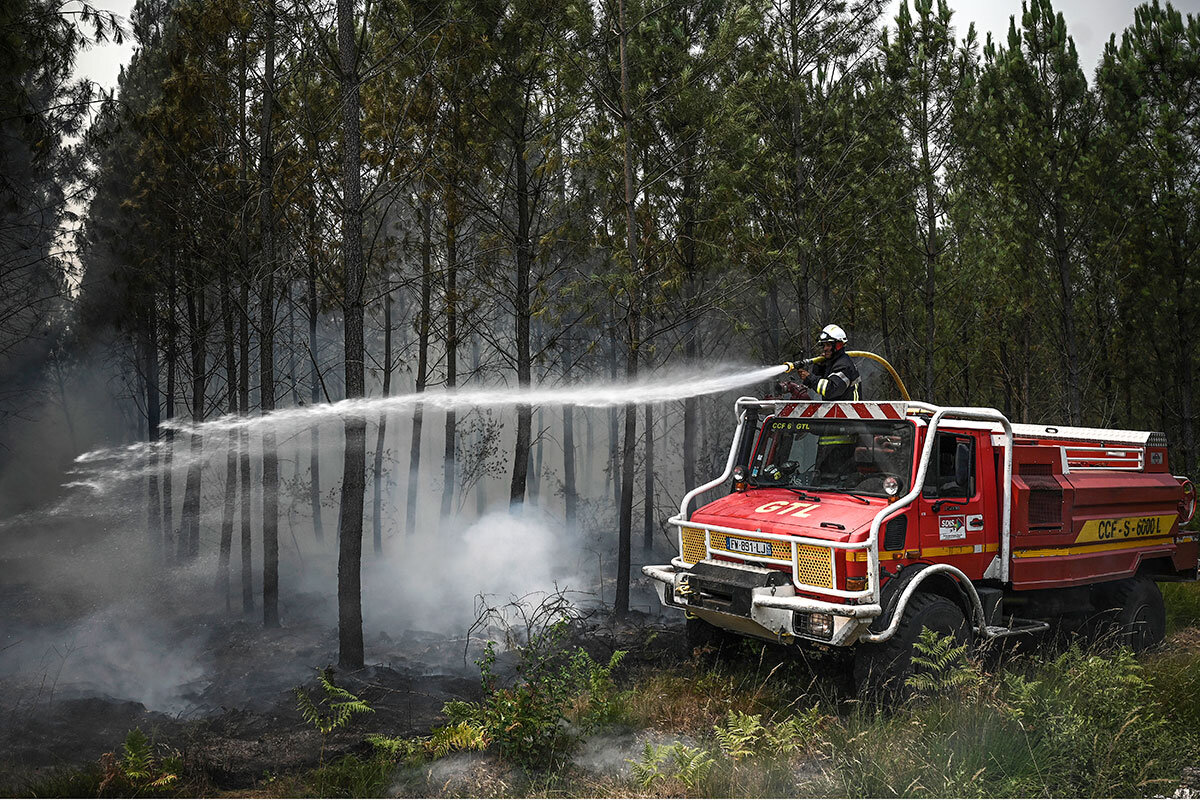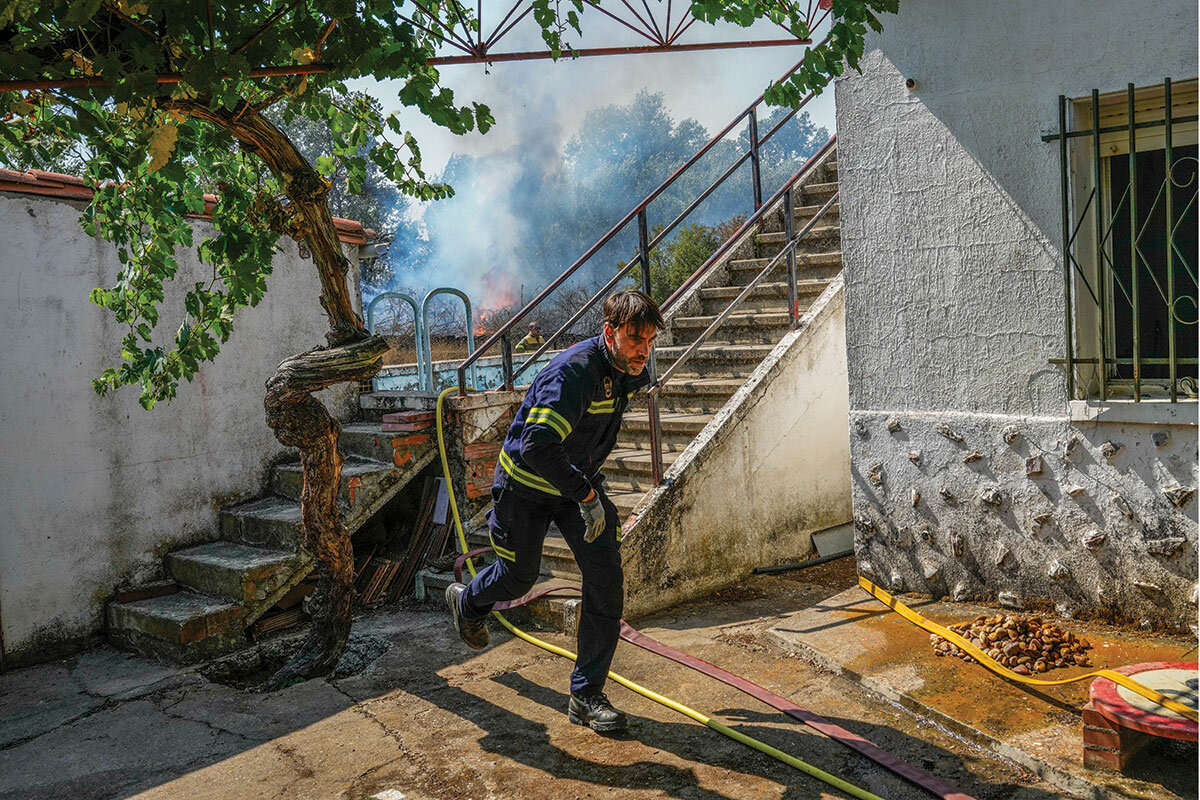Fires sweep a sweltering Europe. How is the EU fighting back?
Loading...
July was ablaze in Europe. This summer’s wildfires nearly engulfed a train traveling between Galicia and Madrid in Spain, creating panic among passengers. Rapid, high flames overtook and killed an older couple fleeing in their car in Portugal. On Aug. 7, on the Adriatic island of Hvar, a Croatian man died protecting his house. Forest fires also forced thousands to flee their homes in southern France.
The wildfires the continent has experienced this season are not its deadliest, but the scenes have been dramatic. In all, wildfires larger than 30 hectares (74 acres) have burned more than 2,300 square miles of land in the European Union this year. “This is the second-highest annual total since 2006,” says Daniel Puglisi, press officer of the EU commission for crisis management and humanitarian aid. And the fire season doesn’t end until October.
Just how bad have wildfires been in Europe?
Why We Wrote This
Like the United States, Europe is facing increasingly fierce wildfire seasons, endangering lives, land, and livelihoods. But the European Union is working on new ways to control the flames.
The number of fires and burned areas has been record-breaking in many countries of the EU. Especially in southern Europe, the number of fires in 2022 significantly surpassed the annual average documented since 2006, the starting point for the data set of the European Forest Fire Information System.
As of early August, Romania has been the country with the most dramatic spike, registering more than 700 fires this year. Flames there consumed 580 square miles (0.6% of the country’s area) compared with an average of 55 square miles annually between 2006 and 2011. Spain, Italy, France, and Croatia have also seen an extreme rise in the number of fires, with the total burned area also representing a notable increase for all but Italy.
Portugal’s wildfires have proved severe enough this summer to prompt the declaration of a state of emergency – no doubt also spurred by memories of the devastating 2017 wildfires, which killed more than 100 people.
“What we’re seeing is a lot of large fires occurring simultaneously that are starting outside of what was the traditional fire season,” says Víctor Resco de Dios, professor of forestry engineering at the University of Lleida in Spain. “More than the number of fires, I think what’s remarkable is that a very large number of large fires are occurring simultaneously on a subcontinental scale.”
What is causing the fires?
The immediate triggers for forest and wildland fires have been kaleidoscopic.
Some fires are sparked by human error or negligence, such as the failure of landowners to remove dead or dry leaves and pine needles from their properties. Others – like the one in the Channel island of Alderney – have been attributed to lightning. Firefighters say the natural phenomenon can be the most dangerous as lightning tends to strike in remote areas where it is more difficult to intervene quickly.
In the Mediterranean, most wildfires are ignited by humans. For example, “the main fire cause in Portugal is human activities, either by accident, negligence, or arson,” says Joana Parente, a postdoctoral researcher focused on wildfires in Portugal. “Yes, we have natural wildfires. However, they only represent an average of 0.5% of the wildfires.” And across Europe, arsonists are to blame in an alarming number of cases, among them an adrenaline-seeking French firefighter.
Hot and dry weather is no help. Europe has experienced a spate of heat waves this summer, and globally July was the third hottest on record. It’s not possible at this stage to conclusively say whether the heat waves are due to climate change. But climate scientists are already analyzing the matter, and experts concur that drought conditions and record-breaking high temperatures that kicked off early this year exacerbated the wildfire situation.
“Of course, the big question is, why do we have that?” says Robert Stefanski of the Geneva-based World Meteorological Organization. “The Intergovernmental Panel on Climate Change is indicating that we will see hotter and drier weather, especially in the Mediterranean areas. So that’s an indication of things to come.”
In Spain and Portugal, economic reasons also play a role, with populations shifting away from rural areas. Wood is no longer collected for energy. The decline of small farmers has transformed the landscape and created conditions conducive to fire spread.
“With climate change, the fuel – the trees, the foliage – dries earlier,” says Mr. Resco de Dios. “So this fuel becomes available earlier than what traditionally is the case. And this climate change is also due to a state of abandonment of forests that are no longer profitable in Europe, especially in southern Europe. Forest management is not profitable, and in many cases, neither is agricultural use.”
“Agriculture is important because [farms] create spatial heterogeneity,” adds Mr. Resco de Dios. “When we have the landscape bisected with agricultural fields, it is more difficult for the fire to become a large forest fire. ... In agricultural areas, fires burn with less intensity and provide a point from where they can be extinguished. But as this spatial heterogeneity is being lost and as everything is becoming more uniform, there are more and more forests with a lot of biomass. And this is a factor that leads to large fires.”
What is Europe doing to address the problem?
While forest fire prevention and response is a national responsibility, the EU budget does carve out €893 million ($920 million) for supplemental support. And within RescEU, the bloc’s disaster emergency response and civil protection resource pool, the EU has assembled a fleet of 12 firefighting airplanes and one helicopter for peak forest fire season. Portugal, France, Slovenia, and the Czech Republic each asked for help from RescEU services once in July. Albania did so in June and July.
The EU also uses satellite data from the Copernicus Earth observation program to analyze wildfires in the bloc and beyond. It evaluates forest fire risk and maps burned areas. This helps preemptive efforts and speeds up firefighting response.
Europe, like the United States, is also opening to the idea that allowing forests to burn naturally – or even setting preemptive burns on purpose – can help prevent mega-fires, especially at a time when models supported by satellite imagery and artificial intelligence provide fairly reliable predictions of fire conduct. But the idea faces pushback from some environmentalists.
Spain in particular shines for the progress it has made fighting fires in recent years. Aerial firefighting has taken off. Firefighters who cut their teeth in the devastating 1994 fires went on to form BRIF, a rapid-deployment specialized brigade akin to the special forces in the army. Spanish universities offer master’s degrees and Ph.D.s focused on forest fires. And in the private sector, companies like Technosylva offer software solutions for wildfire protection planning, operational response, and firefighter and public safety.
“Fire is no longer just something that is burning vegetation, but it’s something that is threatening people, their property, and local economies,” says Raúl Quílez, who has been fighting fires since 1994 and is pursuing a Ph.D. in forest fires in Spain.






